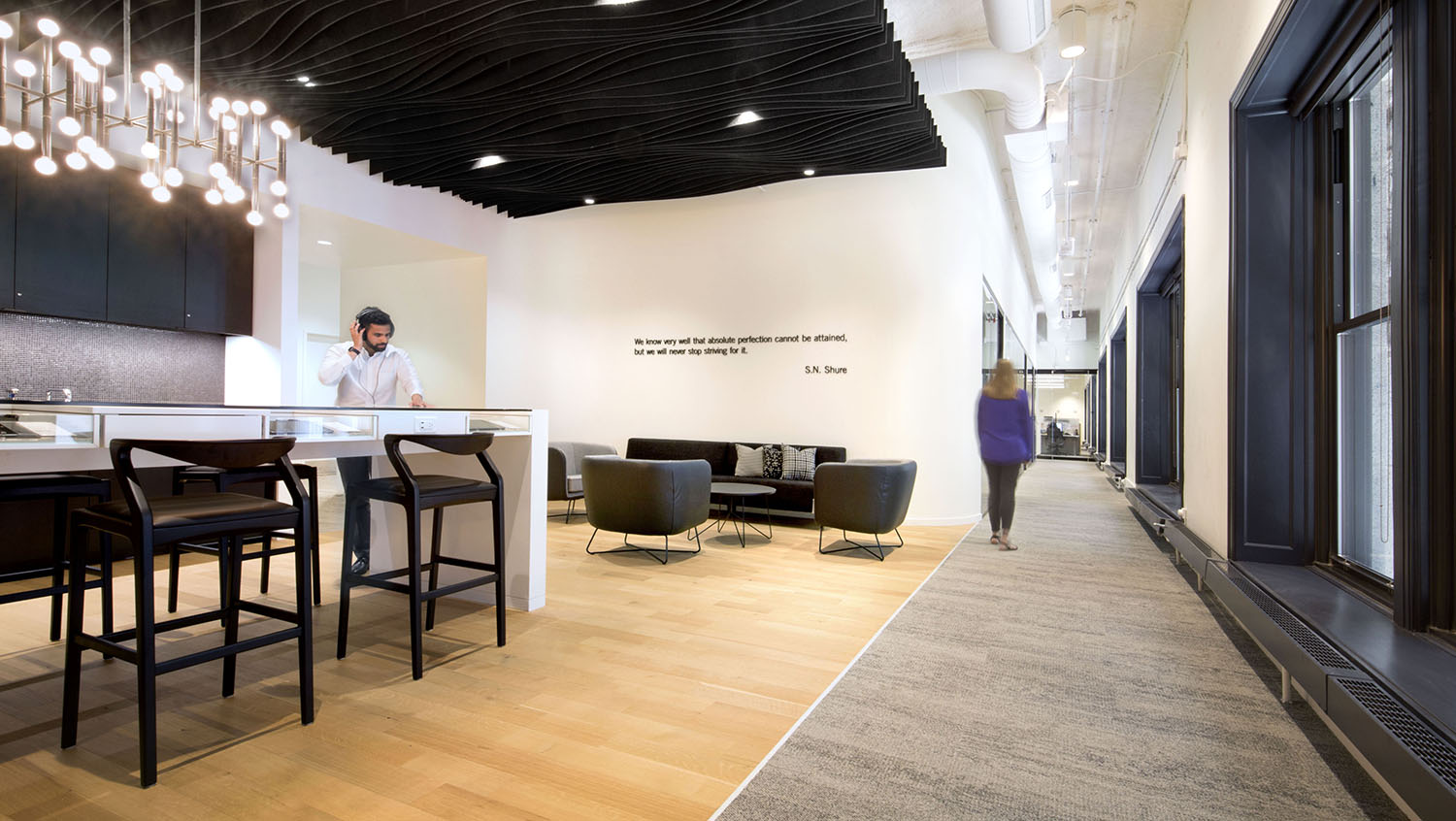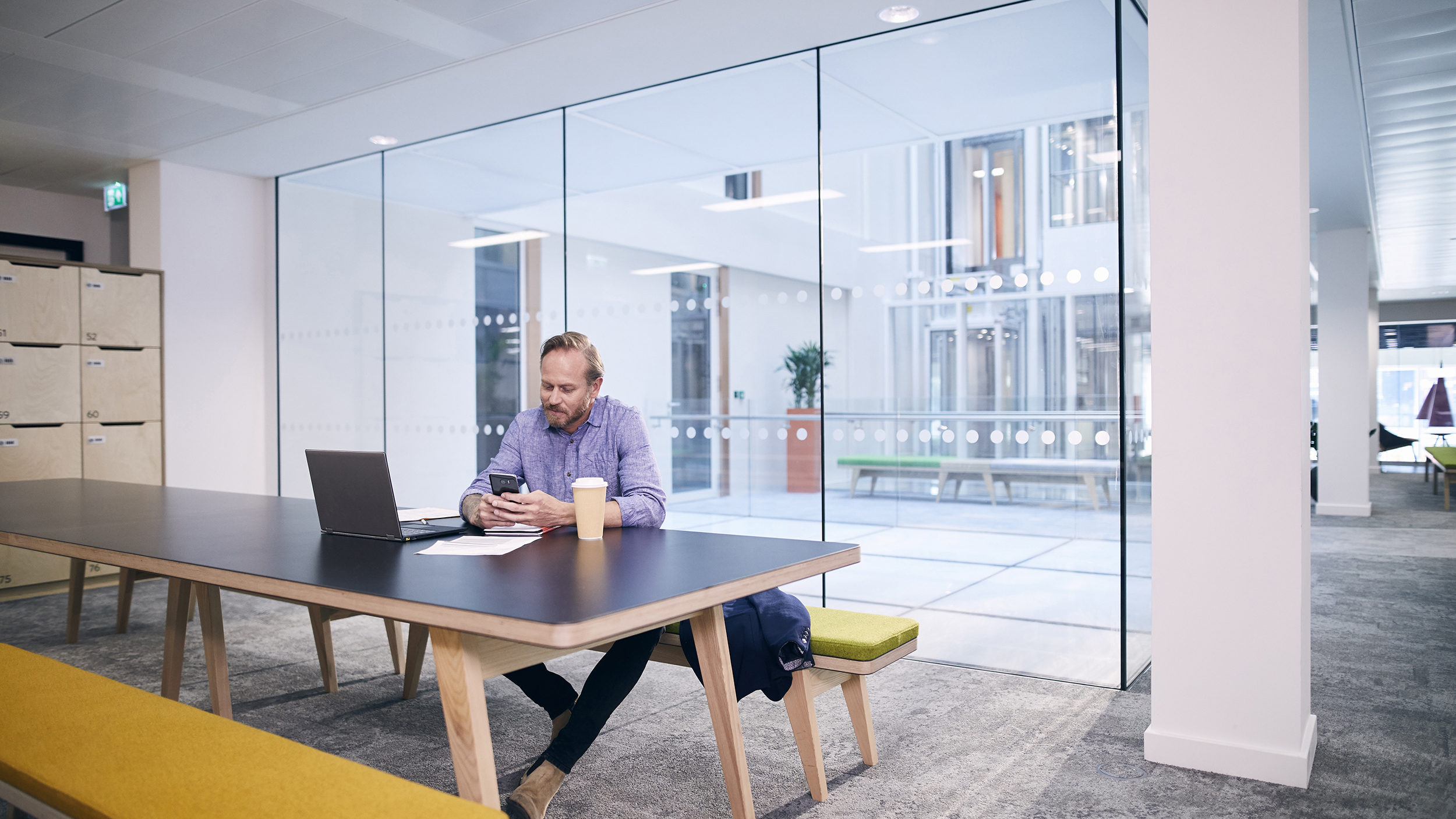Prior to the pandemic, acousticians and audio systems designers grappled with producing quality sound in “fishbowl” conference rooms—spaces featuring glass walls, concrete floors, perpendicular angles, and hard-surfaced furniture . As companies put their hybrid work strategies into practice, many of these issues remain … and a few new ones are presenting themselves.
One of the positive outcomes of our collective work-from-home experience is that people have become more aware of the need for a quality audio experience during conference calls, noted Rob Gilfillan, president of Cenero, an AV systems design and integration firm headquartered in Malvern, PA. “Over the years, everyone was so focused on the video and not as focused on the audio, but if there’s a glitch with the video, the call is going to be fine. If the audio is awful, however, the call is dead because it’s the primary way we communicate,” he explained. The struggle to hear and be heard while conferencing from home underlined just how important audio is.
[ The Future of Conferencing Audio ]
Being forced into working from home for the last few months has many considering how to reconfigure in-office meeting and conferencing spaces so they deliver better experiences for remote participants in a hybrid work environment. “People were forced into having meetings using virtual tools and they had to figure it out—they were forced into adopting them,” Gilfillan said. “In doing that, they realized, ‘Wow, this is a really bad experience when you call into a room. I never realized how bad it was.’ When they go back to the office, I think people will be much more sensitive to that now than they were before, and they’re starting to think about the technology that they need to invest in.”
[ The Integration Guide to Conferencing & Collaboration ]

Joey D’Angelo, president of Joseph D’Angelo and Associates (DNA), an audiovisual and technology consulting firm based in Orange County, CA, relayed that one of the biggest trends he’s seeing is the creation of conferencing “rooms” within an open office plan, but without the traditional four-wall configuration. Instead, organizations are exploring partitions (usually ones able to accommodate a video display) that define a given meeting space within a large, open area. Unsurprisingly, this configuration creates speech privacy issues. “We’re trying to solve these problems with microphones that have directed lobes and cut-off points, and it takes a lot of testing, and trial and error,” he said.
These challenges spill into the open office space where people are participating in videoconferencing from their desks, and thus are exposed to extraneous noise such as ringing telephones, visitors to the office, and the chatter of neighboring colleagues. Acoustic fencing technology offers one solution to this problem, alleviating these distractions from the call itself so that participants on the other end don’t hear them.
[ Why 2021 Will Be the Year of Touchless Audio ]
For those working in an actual office, sound masking solutions—such as those offered by Biamp’s Cambridge Sound—deliver speech privacy in open spaces featuring a lot of ambient noise and chitchat, noted Mark Higgason, executive vice president and partner at Encompass AV, an audiovisual systems design and integration firm based in Elk Grove Village, IL. While he acknowledges that sound masking isn’t a new concept, it’s one that’s being re-examined by organizations as they roll out their hybrid work strategies. “You’re not actually quieting anything. What you’re doing is making human speech unintelligible at a distance. You may still hear the mumble of a coworker on the phone, or one coworker who may be much louder in conversation than another—the sound is still there, but it’s unintelligible and it’s not really distracting,” he said. These solutions also mask noise coming from the HVAC system, and can be used for background music and paging as well.

Higgason also pointed to technologies like Shure’s Microflex microphone series that allow for more precise audio capture in spaces where, once again, ambient noise is a problem. “This newer generation has really allowed us to focus on areas that we want to pick up coverage from and reject the areas we that we don’t,” he said. “Even with bad acoustics, we can still make something far more workable than we could previously.”
[ Sound Reinforcement Remedies ]
Huddle spaces are another area of focus for those returning to the office. With the need to distance people from one another, the concept of cramming three to five meeting participants in a small room is, for the moment, frowned on. For now, many of these spaces have been reduced to mini-offices, reconfigured for one or maybe two people. While capacity limits may have changed in these rooms, their technological makeup has not, Gilfillan noted. “The trend has been that every huddle space will be outfitted with USB video and audio devices, because conferencing in those spaces will be a constant moving forward,” he said.
He added that management platforms such as AppSpace, which feature analytics, monitoring, and reporting, give tech managers and other stakeholders insight into how these spaces are being used as the hybrid workplace evolves. “People are looking at being able to aggregate data to make better business decisions about their meeting spaces in terms of the rooms that are being booked, their size, who’s booking them, and how these spaces are being used. The huddle spaces are going to change based on that data.”
While the current focus may be on the hybrid workplace, D’Angelo believes that once the pandemic subsides, an increasing number of companies will require their employees to spend most of their time at the office. “People were working really hard [from home] during the pandemic because they wanted to keep their jobs and keep their companies strong,” he said. Post-COVID, he argues that productivity—particularly that of remote workers—will decline, driving organizations to make their remote work policies more restrictive. “I think it will be a boon for the AV industry because these companies will have built all of these less dense office buildings, and they’re going to need more, and there will be the need for renovations and changes and new buildings. I think it’s a win-win for the AV industry.”
Standardizing the Virtual Workforce
At the same time, Gilfillan noted that it’s wise to specify USB peripherals that are certified by the conferencing platforms that clients are using. “If, say, a USB microphone isn’t certified [by the platform in question], it might not deliver a great experience,” he said.
After a long spell of cobbling together remote work technologies, there is an argument that companies will begin standardizing the systems used by those who continue to work outside of the office, according to Rob Gilfillan of Cenero. In this model, organizations will list the make and model of the cameras, microphones, and USB devices they want their employees using for conferencing in an effort to control the quality of these calls. “Everyone is sick of being on a call with someone who just opens up their laptop and tries to use the microphone and speakers on that laptop, and they’re in a Starbucks with a lot of people around and shoddy bandwidth, and there is all this noise,” he said.
Click here to read more stories from the September 2021 issue of SCN.
More About Hybrid Work
The Future of Conferencing Audio • Ledetta Asfa-Wossen, September 18, 2020 • With meeting rooms at the nerve center of many companies, understanding the shifting use and technical requirements of the workspace is essential. So, what does the future hold for conferencing audio and specification?
How to Build a Killer Conference Room • Joe Dunbar, July 8, 2021 • We’re finally getting a glimpse of what things at the office will look like moving forward. We all know how we got here, so I won’t bother with that recap, but safe to say we’re seeing the predictions of hybrid offices filled with flexible spaces start to come to life. As some of these discussions and plans turn into realities, I've been reflecting on the key components for a successful conferencing and collaboration space.
Adapting to the Hybrid Workplace • Jennifer Guhl , May 25, 2021 • Before the pandemic, companies were eager to integrate flexible conferencing and collaboration-based technology to increase engagement among employees and conduct global meetings more effectively. Now, however, companies are looking for guidance from technology providers to help them create not only a seamless hybrid working environment, but an intuitive one, too.
Work: In Progress • Margot Douaihy, Ph.D., January 4, 2021 • As more people return to offices, what tools and policies will prove to be essential? What lessons have we learned about UCC, AV, and visualization technologies and team morale during the pandemic?
UC Solutions Balance Safety and Productivity in Wake of COVID • Alex Peras, July 22, 2020 • When the pandemic struck, the move to remote work was swift, but even as more states open up and loosen social distancing restrictions, we will continue to see more companies opt for a hybrid work environment that comprises both in-office and virtual/remote students. This shift to hybrid work creates a unique opportunity for AV professionals to position their services and AV technology as one way to mitigate this challenge of balancing safety and productivity. This includes collaboration and unified communications (UC) solutions, technology platforms that support social distancing, provide important data and analytics, and can be easily added to existing or new systems in spaces of any size or scale.
Hybrid Work Model Increases Demand for Video Collaboration Technologies • Stefan Eriksson, April 26, 2021 • 2020 was a year of global societal change, and one of the most impactful cultural shifts has been the rapid transition to a distributed workplace, with nearly all traditional office-based companies instituting work-from-home policies on a part-time or full-time basis. For custom technology integrators, this movement has created opportunities to introduce clients to new digital tools—particularly video collaboration technologies—and upgrade them for effective communication between traditional offices and countless new home offices.
Office Design: Balancing Capability and Usability • Steve Greenblatt , December 01, 2018 • As organizations are doing more with less office space, technology has to support greater flexibility for multipurpose use, reconfiguration, and a variety of applications.
